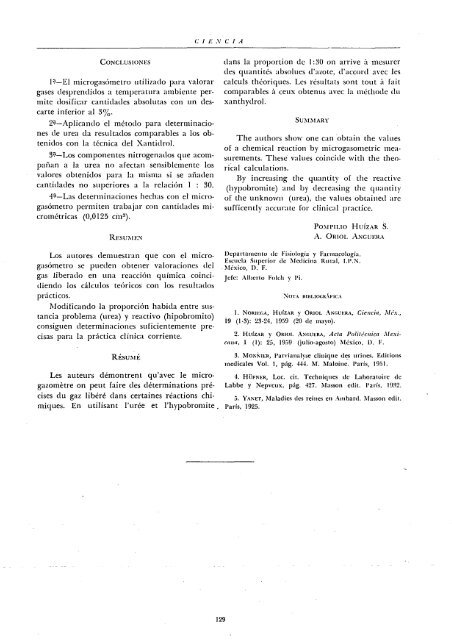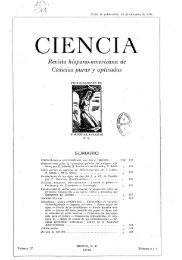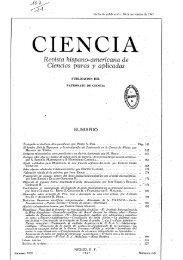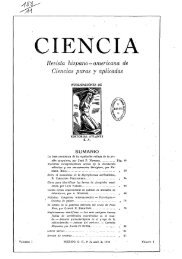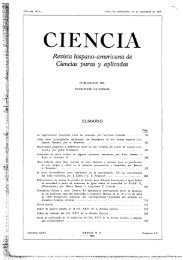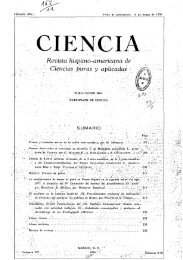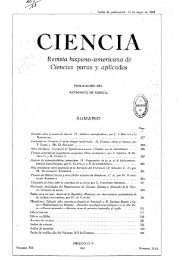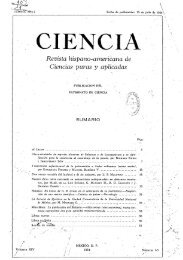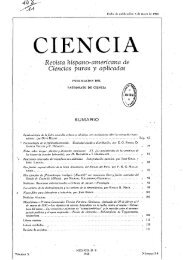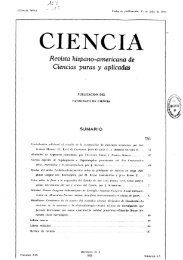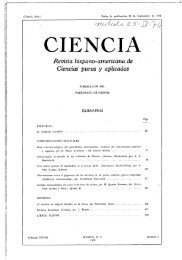Número 6-7 - Instituto de Historia de la Medicina y de la Ciencia ...
Número 6-7 - Instituto de Historia de la Medicina y de la Ciencia ...
Número 6-7 - Instituto de Historia de la Medicina y de la Ciencia ...
You also want an ePaper? Increase the reach of your titles
YUMPU automatically turns print PDFs into web optimized ePapers that Google loves.
e I E .V e I A<br />
CONCLUSIONES<br />
H,-El microgasómetro utilizado para valorar<br />
gases <strong>de</strong>sprendidos a temperatura ambiente permite<br />
dosificar cantida<strong>de</strong>s absolutas con un <strong>de</strong>scarte<br />
inferior al 3%.<br />
2;.l-Aplicando el método para <strong>de</strong>tenninaciones<br />
<strong>de</strong> urea da resultados comparables a los obtenidos<br />
con <strong>la</strong> técnica <strong>de</strong>l Xantidrol.<br />
3;.l-Los componentes nitrogenados que acompaii.an<br />
a <strong>la</strong> urea no afectan sensiblemente los<br />
valores obtenidos para <strong>la</strong> misma si se ai<strong>la</strong><strong>de</strong>n<br />
cantida<strong>de</strong>s no superiores a <strong>la</strong> re<strong>la</strong>ción 1 : 30.<br />
4;.l-Las <strong>de</strong>terminaciones hechas con el microgasómetro<br />
permiten trabajar con cantida<strong>de</strong>s micrométricas<br />
(0,0125 cin:l).<br />
RESVi\IEN<br />
Los autores <strong>de</strong>muestran que con el microgasómetro<br />
se pue<strong>de</strong>n obtener valoraciones <strong>de</strong>l<br />
gas liberado en una reacción química coincidiendo<br />
los cálculos teóricos con los resultados<br />
prácticos.<br />
Modificando <strong>la</strong> proporción habida entre sustancia<br />
problema (urea) y reactivo (hipobromito)<br />
consiguen <strong>de</strong>terminaciones suficientemente precisas<br />
para <strong>la</strong> pdctica clínica corriente.<br />
da ns <strong>la</strong> proponion <strong>de</strong> 1: 30 on arri ve á lllesurer<br />
<strong>de</strong>s quantités absolues d'azote, d'acconl a\'ec les<br />
calculs théoriques. Les résultats sont tout ;\ fait<br />
comparables á ceux obtenus avec <strong>la</strong> métho<strong>de</strong> du<br />
xanthydrol.<br />
SUi\(;\.IARY<br />
The authors sho,," one can 'obtain the \'alues<br />
of a chemical reaction by microgasometric measurements.<br />
These values coinci<strong>de</strong> \Vith the theorical<br />
calcu<strong>la</strong>tions.<br />
By increasing the quanlity oC lhe reactive<br />
(hypobromite) amI by <strong>de</strong>creasing the quantity<br />
uf the unknowll (urea), the values ub<strong>la</strong>ined are<br />
sufficently accurate for clinical practice.<br />
POi\IPILIO HuíZAR S.<br />
A. ORIOL ANGl1ERA<br />
Departamento <strong>de</strong> Fisiología y Farmacología.<br />
Escue<strong>la</strong> Superior <strong>de</strong> <strong>Medicina</strong> Rural, I.I'.N.<br />
. ~réxico, D. F.<br />
Jefe: Alherto Folch y Pi.<br />
1. NORIECoA, HU(ZAR y ORIOL A I\:COU ERA, Ciellcia, "Jéx.,<br />
19 (1·3): 23-24, 19:;9 (20 <strong>de</strong> mayo).<br />
2. HU(ZAR y ORIOL .-\:'\(;UERA, Acta PO/i¡':ClliclI Mexi·<br />
CllIUl. 1 (1): 25, 1959 (julio.agosto) México. D. t·.<br />
RÉsUi\I.É.<br />
Les auteurs démontrent qu'avec le microgazometre<br />
on peut faire <strong>de</strong>s déterminations précises<br />
du gaz Iibéré dans certaines réactions chimiques.<br />
En utilisant I'urée et l'hypobromite.<br />
3. M01\NIER, I'ar\'ianalyse c1inique <strong>de</strong>s urines. Edilions<br />
medicales Vol. 1, pág. 444. M. Maloine. París, 1951.<br />
4. HÜFJl:ER, Loe. cit. Teehniques <strong>de</strong> Lahoratoirc <strong>de</strong><br />
Labbe y Nep\'cux, p¡íg. 427. i\[asson edit. París. 19!~2.<br />
5. y .... I\:I:.-r, ~ra<strong>la</strong>dies <strong>de</strong>s reines en .-\lIIbard. Masson edil.<br />
París, 1925.<br />
129


